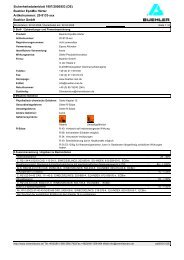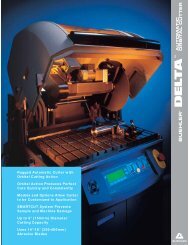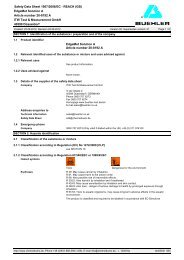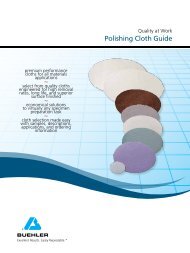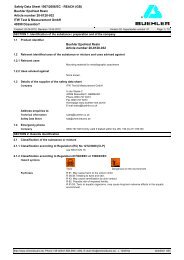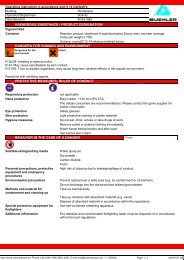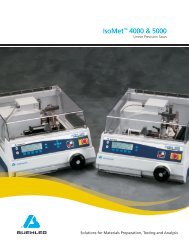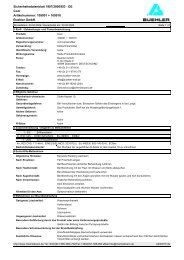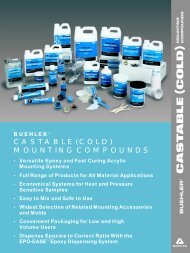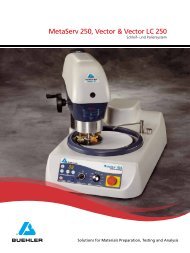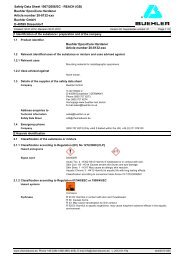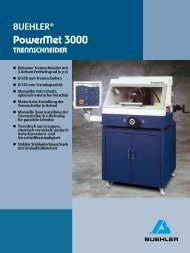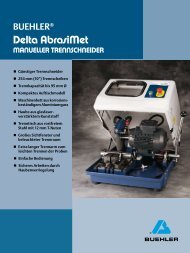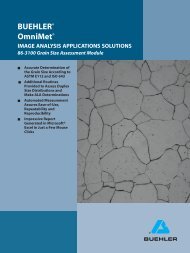Decapsulation & Delidding of Electronic Packages Using the - Buehler
Decapsulation & Delidding of Electronic Packages Using the - Buehler
Decapsulation & Delidding of Electronic Packages Using the - Buehler
Create successful ePaper yourself
Turn your PDF publications into a flip-book with our unique Google optimized e-Paper software.
<strong>Decapsulation</strong> & <strong>Delidding</strong><br />
<strong>of</strong> <strong>Electronic</strong> <strong>Packages</strong><br />
<strong>Using</strong> <strong>the</strong> PetroThin<br />
<strong>Buehler</strong> is <strong>the</strong> Science Behind Materials Preparation and Analysis.
PetroThin Advantages<br />
Mechanical <strong>Decapsulation</strong> <strong>of</strong><br />
microelectronic packages with<br />
<strong>the</strong> PetroThin <strong>of</strong>fers numerous<br />
advantages.<br />
Metal and ceramic packages<br />
that are resistant to chemical<br />
attack can easily be prepared.<br />
Multiple packages can be<br />
decapsulated or delidded,<br />
at <strong>the</strong> same time.<br />
Decapsulate large packages<br />
up to 2”x 3” (5 x 7.6 cm) in size.<br />
The PetroThin allows for a quick,<br />
accurate, and repeatable way <strong>of</strong><br />
Decapping (thinning) before a<br />
final chemical etch. After using<br />
<strong>the</strong> PetroThin, chemically decapsulating<br />
packages takes less<br />
time. The PetroThin will prepare<br />
more than one package at a<br />
time (which shortens <strong>the</strong> overall<br />
preparation time), and removes<br />
chemically resistant materials.<br />
Adjustable<br />
Water /Cutting<br />
Fluid Control Knob<br />
Lighted<br />
Power<br />
ON/OFF<br />
Switch<br />
Precision<br />
Micrometer<br />
for Cutting<br />
Lighted<br />
Vacuum<br />
Pump<br />
ON/OFF<br />
Switch<br />
Failure analysis is a vital part <strong>of</strong> semiconductor and electronics<br />
manufacturing. Diagnostic failure analysis tools provide essential<br />
information about a defect or failure so that a die failure can be<br />
localized and analyzed. <strong>Decapsulation</strong> or delidding is applied in<br />
order to gain access to a die or component in most cases encapsulated<br />
with a polymer. The die is <strong>the</strong>n accessible so that it can be<br />
viewed and in some cases activated to conduct electrical<br />
measurement or verification. This technique is also being used to<br />
determine if electronic components may be counterfeit.<br />
<strong>Decapsulation</strong> & delidding are performed by <strong>the</strong> removal <strong>of</strong><br />
packaging material that covers <strong>the</strong> electronic circuit. Packaging<br />
material is made <strong>of</strong> a polymer, ceramic or metal alloy. Removing<br />
this can be performed mechanically, chemically (using acids) or<br />
with a laser or plasma system. Metal encapsulated packages are<br />
more easily removed by mechanical grinding. Some molding<br />
compounds are a mixture <strong>of</strong> cured epoxies and may be resistant to<br />
chemical decapsulation.<br />
2 <strong>Decapsulation</strong> & <strong>Delidding</strong> <strong>of</strong> <strong>Electronic</strong> <strong>Packages</strong><br />
Self-Contained<br />
Vacuum System<br />
Universal Vacuum<br />
Glass Slide Chuck<br />
Vacuum<br />
Gauge<br />
Hg/K Pa Durable<br />
Splash<br />
Guard<br />
Vacuum Filter<br />
with<br />
Auto-Drain<br />
Vacuum<br />
Release<br />
Valve<br />
Stainless Steel<br />
Cutting/ Grinding<br />
Compartment<br />
(features a door safety<br />
interlock switch)<br />
Digital<br />
(inch/mm)<br />
Micrometer<br />
for Grinding<br />
The PetroThin is ideal for<br />
removing <strong>the</strong>se epoxies and metal<br />
covered packages. Multiple large<br />
and small size packages can be<br />
prepared at one time. The<br />
PetroThin enables a mechanical<br />
decapsulation method and can<br />
easily remove packaging material<br />
to within +5 microns <strong>of</strong> <strong>the</strong><br />
circuitry. After any mechanical<br />
material removal method,<br />
chemical decapsulation or o<strong>the</strong>r<br />
techniques must be employed.<br />
<strong>Using</strong> a mechanical removal<br />
system does speed up <strong>the</strong><br />
chemical treatment time,<br />
especially for chemically resistant<br />
epoxies.
<strong>Electronic</strong> Package Mounting<br />
<strong>Packages</strong> are mounted on a glass<br />
slide with Crystal Bond Mounting<br />
Wax. This is done with <strong>the</strong> aid <strong>of</strong> a<br />
hot plate. Gentle pressure is<br />
applied until <strong>the</strong> wax hardens and<br />
our PetroBond (#38-1490) is ideal<br />
for this application. As a rule <strong>of</strong><br />
thumb, thickness <strong>of</strong> <strong>the</strong> wax is<br />
between 10-20 microns. Samples<br />
do not have to be perfectly aligned<br />
because chemical etching will<br />
remove any remaining material.<br />
Total mounting time varies and<br />
depends on <strong>the</strong> number <strong>of</strong><br />
packages but normally can be<br />
completed within a few minutes.<br />
Multiple IC's are wax<br />
mounted on a glass slide<br />
In this<br />
case, 12<br />
<strong>of</strong> <strong>the</strong><br />
same<br />
packages<br />
were<br />
mounted on a<br />
2” x 3” (5 x 7.6 cm) glass slide. After<br />
mounting, <strong>the</strong> slide was placed on<br />
<strong>the</strong> PetroThin holder and held in<br />
place by a vacuum.<br />
The glass slide which is held by a vacuum is<br />
mounted on <strong>the</strong> PetroThin holder<br />
X-ray top view <strong>of</strong> chip. Notice <strong>the</strong> wire bonds.<br />
Operation<br />
X-ray imaging can provide thickness measurements<br />
to determine how much packaging material should<br />
be removed.<br />
Once mounted, samples are decapsulated (thinned) using only<br />
<strong>the</strong> diamond cup wheel. The cutting blade is not used in this<br />
application. When packages are mounted on <strong>the</strong> PetroThin,<br />
<strong>the</strong> micrometer is set to zero as <strong>the</strong> first package touches <strong>the</strong><br />
cup wheel. After several passes across <strong>the</strong> cup wheel, move <strong>the</strong><br />
micrometer approximately 10 microns. Keep thinning until <strong>the</strong><br />
first circuit becomes exposed or you have removed <strong>the</strong><br />
required amount <strong>of</strong> material.<br />
The entire process from mounting to final thinning takes a few<br />
minutes. Removing <strong>the</strong> packages from <strong>the</strong> glass slide is accomplished<br />
by heating. Any remaining wax can be removed with a<br />
solvent such as ethanol.<br />
X-ray side view before thinning and decapsulating. Notice <strong>the</strong> wire bonds.<br />
X-ray side view after thinning close to <strong>the</strong> wire bonds which are still in tack.<br />
3
Multilayerpackages<br />
© 2010 BUEHLER, a division <strong>of</strong> Illinois Tool Works Inc. Printed in U.S.A. FN01441 *For metallurgical consumables produced by BUEHLER®<br />
BUEHLER, a division <strong>of</strong> Illinois Tool Works Inc.<br />
– Worldwide Headquarters<br />
41 Waukegan Road • P.O. Box 1<br />
Lake Bluff, Illinois 60044-1699 USA<br />
Tel: (847) 295-6500 • Fax: (847) 295-7979<br />
Sales: 1-800-BUEHLER (1-800-283-4537)<br />
www.buehler.com<br />
Email: info@buehler.com<br />
IC top view after PetroThin<br />
decapsulation and chemical<br />
etching. Notice all <strong>of</strong> <strong>the</strong> wires<br />
remain intact and <strong>the</strong> chip is<br />
exposed.<br />
Additional Information<br />
<strong>Buehler</strong>’s advertisements have appeared in Microscopy Today & <strong>Electronic</strong> Device Failure Analysis<br />
magazines. Visit <strong>the</strong> <strong>Buehler</strong> website: www.buehler.com. For additional technical information,<br />
please contact us at info@buehler.com.<br />
<strong>Buehler</strong> continuously makes product improvements; <strong>the</strong>refore,technical specifications are subject to change without notice.<br />
BUEHLER GMBH - European and MESA Headquarters<br />
In der Steele 2 • 40599 Düsseldorf<br />
Postfach 16 03 55 • 40566 Düsseldorf<br />
Telefon: (49) 211 974100 • Telefax: (49) 211 9741079<br />
www.buehler-met.de<br />
Email: info@buehler-met.de<br />
BUEHLER FRANCE<br />
Téléphone: 0800 89 73 71<br />
Télécopie: 0800 88 05 27<br />
www.buehler.fr<br />
Email: info@buehler.fr<br />
BUEHLER UNITED KINGDOM<br />
Telephone: 0800 707 6273<br />
Fax: 0800 707 6274<br />
www.buehler.co.uk<br />
Email: sales@buehler.co.uk<br />
O<strong>the</strong>r Application<br />
Ano<strong>the</strong>r application would be to<br />
remove a chip layer from a multilayer<br />
die stack. If a failure is recorded in a<br />
layer o<strong>the</strong>r than <strong>the</strong> top layer <strong>the</strong>n<br />
removing <strong>the</strong>se layers would be <strong>the</strong><br />
objective.<br />
BUEHLER CANADA<br />
10 Carlow Court, Unit #2<br />
Whitby, Ontario L1N 9T7<br />
Telephone: (905) 430-4684<br />
Fax: (905) 430-4647<br />
Sales Telephone: 1-800-268-3593<br />
Email: info@buehler.ca<br />
BUEHLER, ASIA-PACIFIC<br />
5/F Vogue Centre<br />
696 Castle Peak Road<br />
Lai Chi Kok, Kowloon<br />
Hong Kong, SAR, China<br />
Telephone: (852) 2307 0909<br />
Fax: (852) 2307 0233



